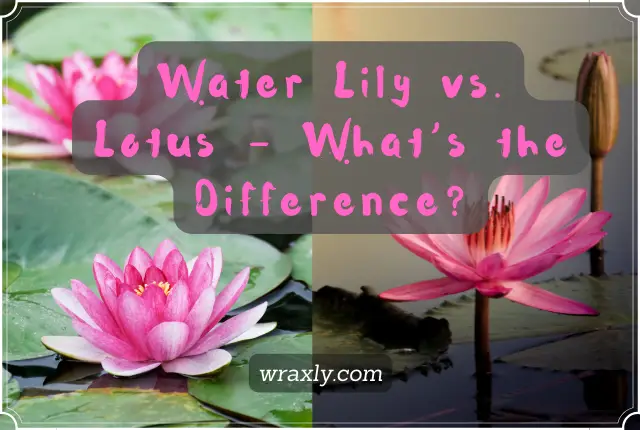For many gardeners, it’s difficult to point out the differences between a water lily and a lotus. After all, these plants share plenty of traits and often grow in similar garden locations.
However, while water lilies and lotus have a lot in common, there remain many ways in which they differ from one another. Finding and understanding these differences can be difficult, which is why we’ve created this quick guide.
As you’ll soon see, we’ve found three main ways in which these two fantastic plants set themselves apart from each other. Read on to learn the specifics of what those differences are.

They Belong to Different Plant Families
We won’t dive too deep into technical classifications. But having a bit of botanical knowledge lets you understand the most concrete way in which water lilies and lotuses are different.
On the one hand, the term “water lily” is a common term that refers to a family of freshwater plants, known as the Nymphaeaceae family. This family includes a total of 58 water lily species that belong to many different parts of the world.
By contrast, the term lotus is less definitive. True lotus plants belong to a genus called Nelumbo and are the lotuses that are most similar to water lilies. However, there are other non-aquatic plants that also include the word “lotus” in their common name.
What’s even more confusing is that some plants that people call lotuses are not lotuses at all. For example, the well-known plant commonly called Egyptian lotus is, in fact, a water lily as it belongs to the Nymphaeaceae family.
Popular Water Lily and Lotus Species
Knowing all botanical differences between these plants can be an admittedly complex approach. What’s often easier is keeping track of a few of the most popular species. Here are the varieties you are most likely to come across:
Common Water Lily Species:
- Nymphaea alba, European white water lily
- Nymphaea odorata, North American white water lily
- Nymphaea amazonica, Amazon water lily
- Nymphaea lotus, white Egyptian lotus
- Nymphaea caerulea, blue Egyptian lotus
Common Lotus Species:
- Nelumbo nucifera, Indian lotus
- Nelumbo lutea, American lotus
As you can tell, there are many types of water lilies, most of which fall into the Nymphaea genus. On the other hand, water-dwelling lotus plants include just two species.
FURTHER READING
- Choosing the Best Water Plants for Ponds
- A Simple DIY Method to Create a Backyard Koi Pond
- How to Plant (and Care For) Japanese Iris [In 4 Easy Steps]
- How to Grow Lily Pads in a Pond
- 13 Beautiful Backyard Pond Ideas [with Pictures!]
You won’t need to memorize all the most common water lily and lotus species. But recognizing a few from the list above can help a lot when trying to spot the differences between these two plant groups.
Water Lilies Grow in More Parts of the World
Water lilies and lotuses don’t just come from different plant families, but they can also come from different parts of the world. It’s true that the native habitat ranges of these two plants do have considerable overlap. However, there are some regions where the water lily grows wild while lotus plants cannot.
Lotus plants have two distinct natural growing locations. The Indian lotus grows throughout most of India, as its name suggests. Its range also expands north through the Himalayan Mountains into parts of Central Asia. Similarly, the America lotus calls much of North America its home.
Conversely, water lily species arise naturally in significantly more locations. Not only do water lilies grow in North America and parts of Asia, much like lotuses, but water lilies also grow throughout regions of Europe, Africa, and South America, where lotus species do not.
Water lilies occur more frequently throughout the world in part because the group includes a larger number of species and in part because those species tend to be more cold hardy. While lotuses rarely grow in regions colder than hardiness zone 5, water lily species can grow in zones 4 to 11.
Recommended Water Lilies
Water Lilies and Lotuses Have Different Physical Traits
Now that we’ve covered some of the more scientific ways in which water lilies and lotuses are different let’s look at some of the more immediately noticeable differences between these plants. Although water lilies and lotuses tend to share many characteristics, there are some variations you can notice if you know what to look for. Some of these variations are rather subtle, while others are more obvious.
Water Lily Flowers vs. Lotus Flowers
Flower appearance is another category in which lotuses and water lilies are more alike than not. However, with a trained eye, you can pick out a few ways these flowers differ. Here are a few of the most noticeable ones:
- Water lily flower petals are somewhat thicker
- Lotus flower petals are thinner and rounder
- Water lily flowers only last a few weeks each year
It may take some time before you stop mistaking water lily flowers and lotus flowers for one another. However, with consistent practice, you may eventually find it easy to know one plant from another based on its blooms.
Recommended Lotus Flowers
Water Lily Leaves vs. Lotus Leaves
Another way to see the differences between the two is by their leaves. Water lily leaves are relatively thick and can have a waxy external texture. Much like its flowers, lotus plants often have thinner leaves as well.
As you’ll soon see, flower and foliage texture are not the only way that you can tell a water lily and a lotus apart. Instead, the way these features appear on each plant often makes for the clearest visual distinction.
Water Lily Growth Habit vs. Lotus Growth Habit
If you want the quickest way to know whether you are looking at a water lily or a lotus plant, you should learn how each of these plants typically grows. While both these plants grow in water, it is their above-water parts that make them easy to tell apart.
The flowers and leaves of water lily species sit just on top of the water’s surface. Meanwhile, lotus plants grow shoots that extend far above the water’s surface.
This difference can be quite stark, and most water lilies reach just a few inches above the water, and lotus plants can extend several feet above the water, carrying leaves and flowers with them.
A Few Similarities Between a Water Lily and a Lotus
By now, you can see that water lilies and lotuses are very different plants in several ways. However, as we’ve alluded to a few times in this article, these plants are, overall, incredibly similar. To round out this article, let’s consider these most prominent shared qualities of water lilies and lotuses. They both:
- Bloom with bright flowers that can come in multiple colors
- Grow in aquatic areas, mainly ponds
- Prefer full sunlight conditions in most cases
- Hold artistic and/or cultural significance
- Survive in multiple continents and hardiness zones
Conclusion
We hope this article helps you remember the key differences between these two plants. As we mentioned above, these plants have different botanical classifications, come from different parts of the world, and have some visual differences as well. But despite those differences, these two plants share the same ability to add a unique charm to just about any garden pond.

John Haryasz is a freelance writer and landscape designer. In the field of landscape architecture, he has contributed to many successful design projects throughout the country. As a writer, John specializes in creating captivating and informative web content. Through that work, he aims to share his design knowledge and promote engagement with the outdoor world.

![How to Water Indoor Plants [Plant Care 101]](https://wraxly.com/wp-content/uploads/2021/03/How-to-Water-Indoor-Plants-Plant-Care-101-1200-1024x576.webp)

![Growing Plants from Cuttings [A Simple Guide]](https://wraxly.com/wp-content/uploads/2021/03/Growing-Plants-from-Cuttings-A-Simple-Guide-1200-1024x576.webp)